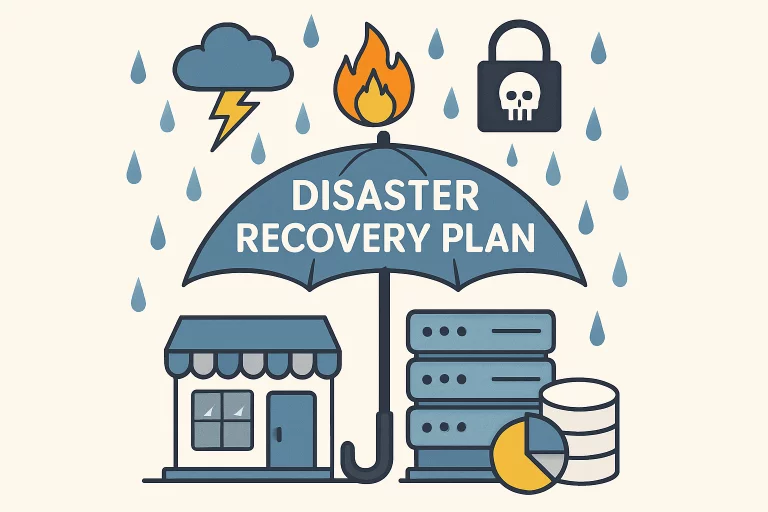Key Takeaways
- Developing a robust disaster recovery plan is crucial for minimizing downtime and data loss.
- Regular data backups, both on-site and off-site, enhance data security and protection.
- Employee training and awareness can help prevent data breaches and facilitate a swift recovery.
- Utilizing cloud-based solutions offers scalability and resilience against data disasters.
In today’s fast-paced and interconnected world, data is the lifeblood of business operations, underpinning everything from routine transactions to strategic decision-making. A sudden loss of critical information can significantly weaken a company, resulting in substantial financial damage, regulatory consequences, and long-term reputational harm. Unfortunately, many organizations remain unprepared and underestimate the profound impacts of data disasters, whether caused by natural events, targeted cyberattacks, or accidental human mistakes. Taking proactive steps, notably by establishing a recovery solution, is essential for safeguarding vital business data and ensuring operational continuity during both anticipated and unforeseen crises.
The lack of a clear, tested disaster recovery plan can have dire implications. Even a few hours of downtime may lead to dramatic revenue losses, erode client trust, and create bottlenecks across workflows. When downtime stretches into days, the costs multiply, impacting long-term business viability. Through the adoption of a comprehensive, multi-layered strategy that incorporates industry-leading best practices for data protection, backup, and employee preparedness, organizations can significantly minimize their risk of catastrophic loss and return to normal operations swiftly, even in the face of disaster.
Understanding Data Disasters
Data disasters manifest in numerous and often unexpected ways. Natural disasters, including hurricanes, floods, wildfires, earthquakes, and even regional power outages, can physically destroy servers and other critical hardware in a matter of minutes, disrupting business for weeks or months. On the digital front, cyberattacks such as ransomware, phishing, malware, and advanced persistent threats can instantly paralyze business processes by corrupting or stealing sensitive information, sometimes demanding hefty ransoms for its return. Nonetheless, not all threats are external; human error remains a leading cause of data loss, ranging from accidental file deletion and misconfigured permissions to poor password practices or simple oversight during routine maintenance. Regardless of the source, the consequences are severe and far-reaching, ranging from service interruptions and regulatory fines to loss of customer confidence and substantial financial harm. Thus, proactive preparation is not merely recommended; it is essential for modern businesses seeking resilience and agility.
Developing a Comprehensive Disaster Recovery Plan
At the heart of any effective data disaster preparation strategy is a comprehensive, detailed, and actionable disaster recovery plan (DRP). Crafting such a plan involves more than checking boxes, as it requires a deep understanding of an organization’s specific risks and dependencies. The process begins with conducting a thorough risk assessment, which involves identifying the full spectrum of natural, digital, and procedural threats that are likely to impact the business, based on factors such as location, industry, scale, and digital exposure. From there, companies must prioritize their systems and data, pinpointing which applications, databases, or information repositories are mission-critical for continued operation versus those with more flexibility in their recovery timeline.
Key Elements of an Effective DRP
- Risk Assessment: Continuously evaluate the threats, both natural and technological, as well as human, that could disrupt or compromise operations, ensuring that evolving risks are considered.
- Data Prioritization: Map out the organization’s most crucial data and applications so the most important assets are protected and restored first in any recovery scenario.
- Recovery Objectives: Clearly define Recovery Time Objectives (RTOs) and Recovery Point Objectives (RPOs), setting targets for acceptable downtime and data loss to guide fast, efficient recovery.
- Communication Plan: Establish comprehensive internal and external communication protocols to keep stakeholders informed, minimize confusion, and maintain transparency throughout any disruption.
However, drafting the DRP is only half the battle. Regular review, ongoing updates, and systematic testing of the plan are vital. These efforts ensure the recovery strategy remains robust, reflects business changes, and exposes weaknesses before a real disaster strikes. With proper governance, businesses reinforce their ability to withstand diverse data disasters and bounce back stronger than before.
Implementing Regular Data Backups
Consistently backing up business data is the single most fundamental step in any robust data protection plan. The widely adopted 3-2-1 backup rule provides a best-practice blueprint: keep at least three copies of all essential information, stored on two different types of media, with one copy maintained off-site or in the cloud. This approach shields businesses from numerous scenarios, ranging from minor hardware malfunctions and human error to major disasters affecting their primary premises.
Employee Training and Awareness
While sophisticated technology is critical, people remain a business’s most important asset, and sometimes, its most significant vulnerability. Employees represent both a potential risk and a powerful line of defense against data disasters, especially when it comes to cyber threats. Ongoing, organization-wide education on cybersecurity best practices, data handling procedures, and the latest threat trends helps reduce the likelihood of accidental breaches, costly mistakes, and delayed responses in the face of real incidents.
Effective training should cover topics such as how to identify and report phishing emails, create and maintain strong authentication credentials, protect both physical and digital devices, and follow incident response protocols correctly. In addition to scheduled annual training, businesses should supplement it with periodic phishing simulations, impromptu spot checks, and hands-on scenario planning exercises. These approaches help build employee “muscle memory” so that, in critical moments following a data incident, staff members respond automatically and decisively. Ultimately, a well-trained and vigilant workforce makes the difference between a minor disruption and a major catastrophe.
Leveraging Cloud-Based Solutions
The increasing adoption of cloud technology has revolutionized the way businesses approach data protection and disaster recovery. Cloud-based solutions provide unmatched flexibility, scalability, and built-in resilience. Top-tier cloud providers leverage redundant infrastructure, storing client data across multiple geographically dispersed data centers. This ensures that localized disasters, whether natural or artificial, do not compromise essential business information. Moreover, the cloud enables seamless collaboration and data accessibility for remote and distributed teams. This advantage became even more apparent during the widespread shifts to remote work brought about by recent global challenges.
Benefits of Cloud Disaster Recovery
- Scalability: Instantly scale storage capacity and compute resources up or down, adapting to business growth or changing demand without significant hardware investment.
- Redundancy: Rely on automated data replication across secure cloud environments to safeguard against hardware failure or regional disruptions.
- Accessibility: Ensure that, in the event of a disaster, users can quickly and securely recover data from anywhere in the world, on almost any device, supporting business continuity regardless of the circumstances.











